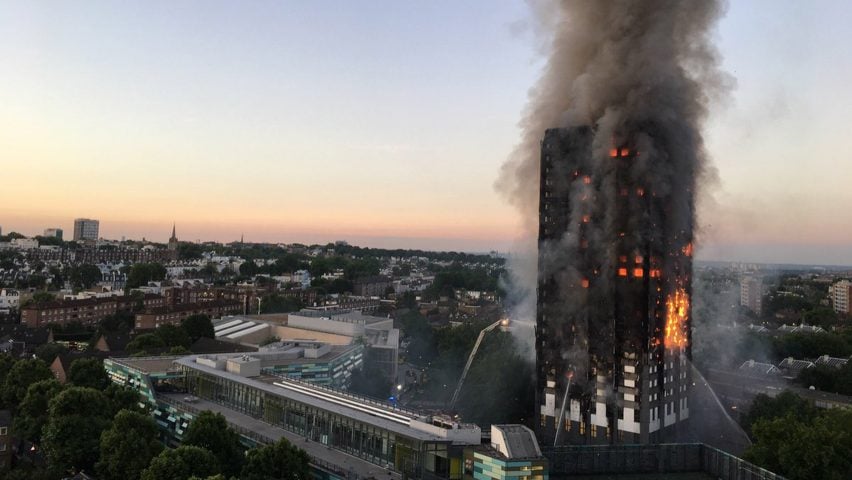Fire-safety guidelines for tall buildings in the UK are unclear and offer too many opportunities for corner cutting, according to a review of building regulations commissioned following the Grenfell Tower fire.
An interim report of the review published today deemed current regulations and fire safety guidance are high-rise buildings is not fit for purpose.
"The work of the review to date has found that the current regulatory system for ensuring fire safety in high-rise and complex buildings is not fit for purpose," reads the report, which was written by engineer Judith Hackitt.
"This applies throughout the life cycle of a building, both during construction and occupation, and is a problem connected both to the culture of the construction industry and the effectiveness of the regulators."
Hackitt, made a dame for her services to health and safety, and engineering, is leading the Independent Review of Building Regulations and Fire Safety, which was commissioned after a fire at Grenfell Tower in west London claimed the lives of 71 people.
Building regulations need to be streamlined, says report
The report, which focuses particularly on the official guidelines in place for high-rise residential buildings, calls for the regulations to be streamlined and for more clarity on where responsibility lies.
"There is plenty of good practice but it is not difficult to see how those who are inclined to take shortcuts can do so," writes Hackitt in the report's forward.
"Change control and quality assurance are poor throughout the process. What is initially designed is not what is being built, and quality assurance of materials and people is seriously lacking," she continues.
Review calls for more user-friendly guidelines for architects
The report's interim recommendations to government include creating more user-friendly Approved Documents – a set of guidelines on meeting building regulations – with particular attention to be paid to Approved Document B, which deals with fire safety.
It also states that responsibility for ensuring a building is fit for purpose should lie with those who commission, design and build the project; that there should be more effective enforcement of rules and stronger sanctions for those who err from them; and that professional and accreditation bodies should develop a joined-up system to ensure workers on complex projects are adequately qualified.
"I have been shocked by some of the practices I have heard about, and I am convinced of the need for a new intelligent system of regulation and enforcement for high-rise and complex buildings which will encourage everyone to do the right thing and will hold to account those who try to cut corners," wrote Hackitt.
"Those responsible for high-risk and complex buildings should be held to account to a higher degree."
RIBA demands ban on combustible cladding
The Royal Institute of British Architects (RIBA) criticised the terms of reference for the report earlier this summer, saying the review focused too strongly on high-rise residential blocks and neglected other typologies, as well as the procurement process.
In a statement released today, the RIBA welcomed the report's plans for clearer guidance, but pressed for a stronger stance on the use of combustible cladding – which is blamed for the spread of the fire at Grenfell Tower.
"It is disappointing that the interim review has not called for an immediate prohibition on the use any combustible materials in the external wall construction of high-rise buildings. This means we continue with this grey-area in regards to fire-safety," said Jane Duncan, RIBA's former president and chair of the body's Expert Advisory Group on Fire Safety.
The RIBA criticised the report's soft stance on Approved Document B. It called for an immediate ban on the use of combustible material in the walls of high-rise buildings, the deployment of sprinklers in residential buildings and the requirement for at least two staircases to offer additional escape routes.
The final report will be published in spring 2018.
Report was commissioned following Grenfell tragedy
Grenfell Tower caught fire in the early hours of 14 June 2017. The spread of the fire is believed to have been accelerated by aluminium-composite cladding applied to the 24-storey residential block during renovation works.
In summer 2016, a £8.7 million refurbishment of the 1970s building in North Kensington, west London, was completed by British Studio E Architects, with Rydon as the contractors.
Following the fire, the government ordered emergency testing of the cladding on 4,000 towers across the UK.
Several blocks found to have the same cladding at Grenfell Tower were stripped of their facades as a precautionary measure.
In August 2017, the government launched a review of building and fire safety regulations, which is running concurrently with the Grenfell Tower Inquiry.
Find out more about the Grenfell Tower fire ›

